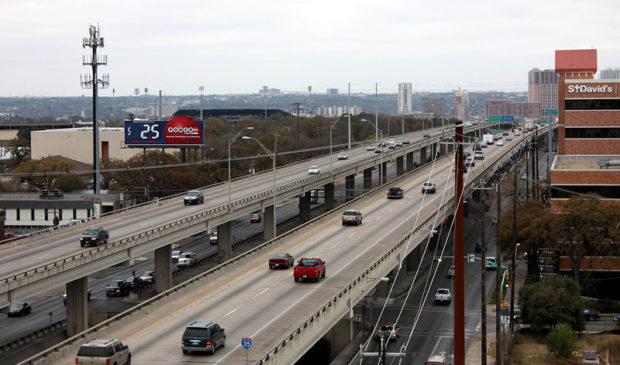Texas Transportation Commission ties billions of dollars to I-35 central project
Friday, May 1, 2020 by
Ryan Thornton The Texas Transportation Commission amended its 2020 Unified Transportation Program on Thursday morning, throwing in $3.4 billion for the $6.6 billion central piece of the Interstate 35 Capital Express project that would expand the interstate between U.S. Highway 290 East and Ben White Boulevard.
The project currently has no final design, and economic troubles from Covid-19 have thrown otherwise steady funding sources into question. Still, the decision reflects the Texas Department of Transportation’s preference to move forward with the project sooner rather than later, saving an estimated $1 billion by aligning construction with the Capital Express north and south projects and getting ahead of economic inflation.
The vote adds to the $560 million already included for the project in the 2020 UTP, but TxDOT Executive Director James Bass said the amendment should be understood as a guiding plan more than a commitment.
“If you were planning on making a trip and started to say, ‘Next year I want to make a trip to New York City’ and you started to plan for that, you have not made a funding commitment,” Bass said. “Now, if you buy a nonrefundable airline ticket, at that point you would make a funding commitment. By nearly planning and budgeting for a future activity, that is not a funding commitment nor a funding decision. It’s merely a planning technique.”
Even so, in the middle of major disruptions to the oil industry and state sales taxes, which both contribute heavily to state transportation funds, Commissioner Alvin New of San Angelo called for a slower, more cautious funding plan spread out over the next two or three years. New said the slower approach would do a few things: allow the state to top off underfunded projects in the 2021 UTP, which he said currently looks “very lean”; provide time to gauge the economic impacts of Covid-19; and allow for a more thorough, non-virtual public meeting format.
New proposed to table the vote and bring it back in August as part of the 2021 UTP adoption process, saving the $3.4 billion for the future. “We are two months from the very likely final version of the 2021 UTP, and we’re talking about making an amendment to a document that is eight months old and 60 days from not being the current UTP,” he said.
Commissioner Laura Ryan said she shares the “immense uncertainty with regard to future budgets and cash flow projections,” but moved to go forward with the amendment with the knowledge that the project could be removed or delayed if the oil industry is unable to recover.
“As it sits today, this project is expected to be completed sometime after 2028, 2029, meaning that should cash not be available to TxDOT at the time of expected letting, the project would get pushed to a later date when the funding is available,” Ryan said. “This would give us time to develop the project and better understand the long-term impacts.”
Last year, the segment of I-35 through Central Austin ranked as the state’s second most congested roadway. According to Brian Barth, transportation program officer at TxDOT, the Capital Express project would likely move the corridor down to a spot in the 20s or 30s on the list of most congested roadways when the project is complete.
Jeff Moseley, CEO of Texas Association of Business, falls into the category of people TxDOT considers “for” the project while objecting to the proposed funding mechanism.
“TxDOT is right to prioritize I-35 through Austin, but in these times of twin economic crises of oil and Covid-19, Texas should again utilize private funding and managed toll lanes to fix I-35, rather than spending $3.4 billion from TxDOT’s discretionary fund at this time,” he said.
Overall, out of 1,490 individuals who indicated support for the project, 290 objected to the proposed funding mechanism. In addition, 1,210 comments opposed the project, 1,090 took no position and 46 suggested postponing the amendment. Without an alternative funding mechanism, New said the 290 comments opposing the UTP amendment would more correctly be considered as against the project.
“Respectfully, what they’re saying is, ‘We need this project; we don’t need to do it this way.’ If you put those people from the ‘for’ column into the ‘against’ column, which is what I think they are, there are actually more people saying we should not be doing this than there are saying we should be doing it,” Moseley said.
The commission approved the amendment 3-1 with New opposed.
“I believe there’s a better way and that we can fund this project effectively and keep it on track without doing what we’re doing today,” New said.
At its April 20 meeting, the Capital Area Metropolitan Planning Organization committed to redirect $633 million of its state funding from various regional transportation projects in order to fill part of the remaining funding gap and get I-35 fixed as soon as possible. The agency’s Transportation Policy Board is scheduled to adopt a final list of deferred projects at its June 8 meeting.
Following the vote, Dewitt Peart, president and CEO of Downtown Austin Alliance, expressed strong support of the commission’s decision, noting the project’s potential to help create improved east-west connections across I-35 for those on foot or bicycle as well as those traveling in cars.
“This project will create jobs and capital investment in our region’s economy, as well as help reduce congestion and keep commerce moving,” Peart said. “There is much to be done, but in the meantime, the Downtown Austin Alliance is forging ahead with the community engagement process for the master planning of the surface enhancements and connections along I-35 through Central Austin.”
Photo made available through a Creative Commons license.
The Austin Monitor’s work is made possible by donations from the community. Though our reporting covers donors from time to time, we are careful to keep business and editorial efforts separate while maintaining transparency. A complete list of donors is available here, and our code of ethics is explained here.
You're a community leader
And we’re honored you look to us for serious, in-depth news. You know a strong community needs local and dedicated watchdog reporting. We’re here for you and that won’t change. Now will you take the powerful next step and support our nonprofit news organization?




